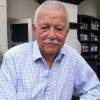By NICK PACHELLI, The New York Times
Sunlight broke through the low-hanging clouds over the public tennis courts at Palm Park, 15 minutes from Ernesto Escobedo’s family home. But Neto, as he is called, packed his eight rackets back in his bag. It had started raining again. He looked west, where it was brighter.
“Let’s go try Carson — see if the courts are dry there,” he said before heading for the United States Tennis Association training center, 20 miles away.
It was the day before Escobedo was to fly to Acapulco for the Abierto Mexicano Telcel, Mexico’s most prestigious professional tournament, where a wild-card entry awaited him.
“It’s like a hometown tournament,” Escobedo said. “My aunts and uncles and cousins will all be there.”
His journey toward the top 100 in the tennis rankings has its roots in a backyard in Mexico, where his grandfather taught his father how to play. Nurtured on the public courts of Los Angeles, Escobedo, 20, is blazing a trail for young Mexican-Americans with a sporting narrative similar to the Williams sisters’ in its genesis and improbability.
Some of the factors that make Escobedo a top prospect are not hard to spot. There is the serve that can exceed 135 miles per hour; the penetrating power of his forehand; the strength in his 6-foot-1, 180-pound frame; the assured way he wields his Babolat racket; and the precision with which he swings through the baseline.
Since the summer’s grass-court season, Escobedo has qualified for the main draw at two ATP Tour events and won two tournaments on the Challenger Tour, the second-tier pro circuit. Along the way, he beat other young Americans like Frances Tiafoe, Stefan Kozlov and Ryan Harrison.
Ranked 113th in the world last week, Escobedo reached the second round at the United States Open in August and at the Australian Open in January.
“He has shown he can play and beat the best players,” said Peter Lucassen, Escobedo’s coach. “Now it’s about being as consistent as possible at a high level.”
He added, “We’re working on taking over the point, attacking more.”
Escobedo’s forceful style is not unusual in the men’s game, but he differs from most of his peers in that he never left home to advance his career.
Today’s paradigm for player development often involves tennis academies, where young phenoms may leave behind their families and traditional education.
But Escobedo continued to live at home with his parents and his two older sisters even after turning pro. He turned down an offer to move to a Florida tennis academy at 14.
“He wasn’t ready,” his mother, Cristina Escobedo, said.
His father, Ernesto Jr., said: “And I’d miss him too much. So we had to just follow what we could do ourselves.”
The Escobedos committed to developing Neto’s game on public courts around Los Angeles with a $5,000-per-year budget. The Lawn Tennis Association of Britain has estimated that the cost of developing a player from age 5 to 18 is more than $300,000.
“Ernesto is a great example that you don’t have to play in a private club or country club to have success,” said Katrina Adams, the president of the U.S.T.A.
Backyard Beginnings
The Escobedos’ living room in West Covina is decorated with memories of a life spent chasing tennis treasures: a shrine to Rafael Nadal; framed photos of the three children with Jimmy Connors, Steffi Graf, Anna Kournikova and Stefan Edberg at the annual tournament in Indian Wells, Calif.; Roger Federer’s shoe, wristbands and shirt from the 2016 Australian Open, perched near one of John McEnroe’s rackets; a parcel of red clay from Roland Garros on the wall next to a stringing machine.
Flipping through family albums, Escobedo’s father tapped a photo of himself in knee-high socks hitting against a wall. He was 12.
“This, our tennis, comes from my hometown, from my dad,” Ernesto Jr. said.
In Jerez, Mexico, Ernesto Jr., the oldest of 10 children, and his father built a tennis court in their backyard. It had smaller dimensions than a regulation court and a piece of wire for a net, but it nonetheless molded Ernesto Jr. and his sister Xóchitl into budding tennis players. Xóchitl went on to represent Mexico in the 1988 Summer Olympics in Seoul, South Korea.
Ernesto Jr. played in the United States, Europe and Mexico but never earned an ATP point.
“He told me stories of sleeping in tents in parks near the courts with his friends,” Neto said, shaking his head in disbelief while his father laughed.
“Our family, we’ve always been coming from nowhere,” Ernesto Jr. said.
Ernesto Jr. married Cristina in Jerez before moving to the United States. Upon arriving in California, he picked strawberries for $20 a day. He eventually found a job driving for UPS, and he has stayed with the company for nearly 30 years.
Neto, who was born in Los Angeles, became enchanted by tennis before he could walk.
“After my mom dropped my sisters off at school, we’d hit and bounce balls against a wall at their school,” he said.
He used a Spider-Man racket then. “I didn’t know that tennis was a sport rich people played,” Neto said. “I just always knew I was going to play.”
When Neto was 5, his father curbed his work hours to coach him, and in 2001, the Escobedos moved to their current home to be closer to a public tennis facility. With West Covina as their home base, they crisscrossed the Los Angeles area for 12 years, finding new part-time coaches and hitting partners.
Rising Unnoticed
In his junior years, Neto stayed in Southern California. He was able to enter the important Orange Bowl tournament in Florida only once because he lacked the resources to travel. And he was not winning tournaments; he would make the quarterfinals or semifinals and then crash out.
Get the big sports news, highlights and analysis from Times journalists, with distinctive takes on games and some behind-the-scenes surprises, delivered to your inbox every week.
“In those years, so many people said I’m not going to make it,” he said. “I’m too slow. I’m too big. ‘He’s not that good. He doesn’t even have a coach. His coach is his dad.’”
Escobedo turned pro at 17. He had planned to attend the University of Southern California on a full scholarship, but once an offer came through to sign with the agent Andrew Kessler and the K3 Tennis Agency, “it was a no-brainer,” Escobedo said.
Despite Escobedo’s improving performances and rising ranking, he has gone largely unnoticed among the heralded group of players in their late teens and early 20s.
“He’s improved a lot in the last 18 months,” said Brad Gilbert, an ESPN analyst. “I’m impressed that he’s moved up more quietly than some of the others.”
Between bites at his kitchen table, Escobedo said, “I do want to shock people.”
He was looking at a picture from the Twitter account for the Next Gen ATP Finals, a season-ending tournament for 21-and-under players to be held in Milan in November. Alongside top foreign prospects like 20th-ranked Alexander Zverev of Germany were Taylor Fritz, Tiafoe and Jared Donaldson, 21-and-under American players who have been ranked near Escobedo for the past year.
“I see the photo every single day; it’s everywhere,” Escobedo said. “They’re great players, and I think I deserve to be there, too, but I’d rather people be like, ‘Where the hell did this guy come from?’”
Escobedo wants to qualify for the tournament, the first of its kind on the ATP Tour. The top seven under-21 players in the rankings and a wild card will make up the field. Two months into the season, Escobedo was 12th in the race to Milan entering Sunday.
He is no stranger to feeling like an outsider. He is the only Mexican-American man in the top 500, and the first to break into the top 200 since Pancho Gonzales in the 1960s.
Rising through the tennis ranks has also challenged Escobedo to reckon with his cultural identity.
“I actually feel more Mexican than American,” he said. “I’ve always lived in the States, and I’m very happy to represent the U.S. — the U.S.T.A. has been very supportive — but I feel much more at home playing in Mexico. More people know about me there.”
At the United States Open, when Escobedo played Kyle Edmund of Britain in the second round, “even the American fans were going for the British guy,” Escobedo’s sister Evanka said, laughing.
Escobedo does not dwell on it. He acknowledged that his identity as an American and a Mexican would continue to evolve. But in the wake of the 2016 presidential election, Escobedo’s thoughts on the flag that follows him around the world have weighed heavier.
“I felt a little bit embarrassed, just how you could see there’s still racism in the world,” he said.
The election even came up when Escobedo trained with Federer for three weeks in November. “Fed asked me, ‘How did he win?’” Escobedo said of President Trump.
Escobedo has not yet honed his voice on public and political discourse, but he said, “If I won the U.S. Open and was invited to the White House, I wouldn’t go.”
Becoming the best American player and matching the success of his childhood idol, Andy Roddick, is Escobedo’s ultimate goal. Eventually he would like to open a tennis academy in Mexico.
The Escobedo family — father, aunts, uncles and cousins included — convened in Acapulco last week for Neto’s match against Kozlov. They held a sign that read: “Vamos Neto. Porra Jerez!”
Escobedo won, 6-1, 2-6, 6-0, before losing to a fellow American, Steve Johnson, in the second round. Breaking into the top 100 would have to wait.
Next for Escobedo will be this week’s qualifying tournament at another hometown event of sorts, the BNP Paribas Open in Indian Wells.
“I’ll have less support in Indian Wells than Acapulco,” he said, “but who knows? That might change.”
First, Escobedo returned home to his mother’s cooking; his dogs, Coco and Gucci; and his childhood room, full of tennis posters with handwritten quotations on the back. He will train with Lucassen, his coach, in Carson or on the public courts near his house.
Then he will drive to Indian Wells with his parents and his sisters close behind. His 84-year-old grandfather, Ernesto Sr., who built the tennis court in his backyard in Mexico decades ago, might come, too.
At home, there is little talk of Escobedo’s ranking. His father maintains that he has not looked at it since Escobedo turned pro. Not yet, at least.
“I’ll jump up and down when he breaks the top 100,” Ernesto Jr. said.
He let his gaze drift off. A wide smile broke through.
“Just imagine me: I used to play with my dad and dream about the top 100 on the court in our backyard,” he said. “Then my kid, 30-something years later, makes it happen, and my dad’s still around.”
Your Editor Applauds: Being Binational and Bilingual helps in the age of Trump
 Next month we’ll launch a three-month campaign to foster and encourage the use of two languages, Spanish and English, among Latinos in the U.S.
Next month we’ll launch a three-month campaign to foster and encourage the use of two languages, Spanish and English, among Latinos in the U.S. 
